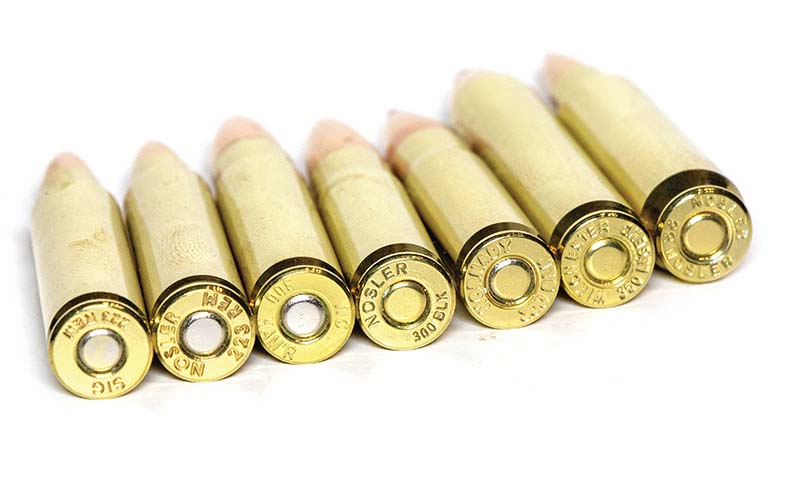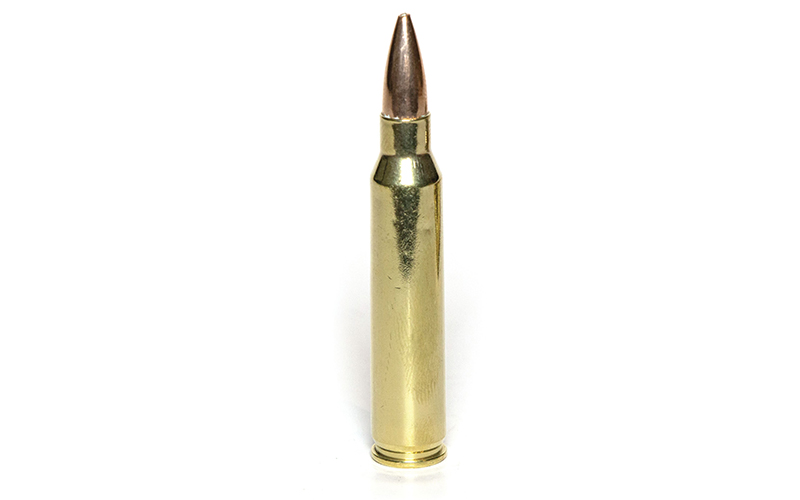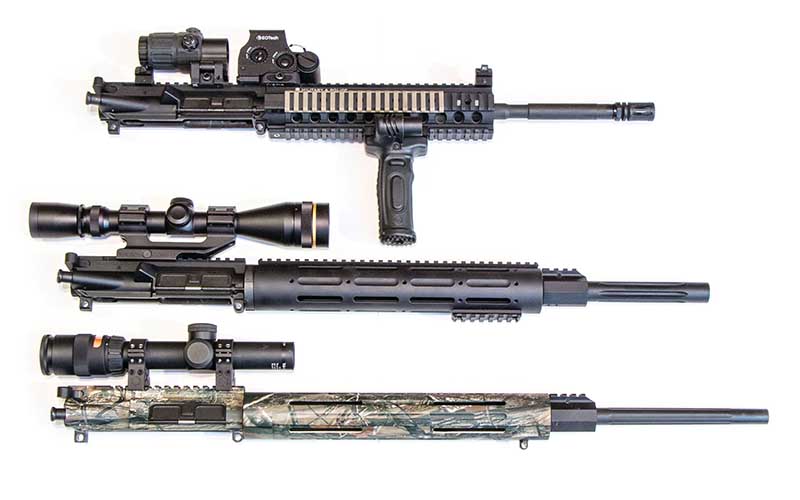
The .223 Remington cartridge and its AR-compatible offspring.
The M16/AR15 was originally chambered for the .223 Remington (1962), and since then that cartridge has become the patriarch of several very useful cartridges that are also AR-15 compatible.
Metallic rifle cartridges come in families. In the .30-06 family, you have the .270 Winchester and .280 Remington. In the .308 Winchester family, you have the .243 Winchester and 7mm-08 Remington. Though the .223 Remington now has its own family, it was based on the .222 Remington (1950), which was a proprietary cartridge, meaning it wasn’t based on another SAAMI-approved cartridge.
If you want an AR-15 that’s multi-cartridge compatible, it makes sense to choose cartridges from the same family. This will allow a conversion with nothing but a barrel or barreled upper receiver. Since the cartridges all come from the same family, you won’t need to replace the bolt carrier or bolt, because the rim diameter for all the cartridges is the same.
With an AR-15 chambered for the .223 Remington, you can do this and run five other cartridges. Here’s a look at the .223 Remington, and the family of AR-15-compatible cartridges it has fathered.

.223 Remington (1962)
The development of the .223 Remington is intrinsically linked to the M16, which is the full-auto version of the civilian rifle now known as the AR-15, or in more politically correct circles, as the MSR (modern sporting rifle). The military would ultimately replace the .223 Remington with its twin, the 5.56 NATO, but that didn’t have any impact on the cartridge’s popularity. Since its introduction, it has become very popular for competition, hunting and self-defense.

Though many will argue it doesn’t suffice for deer or any type of big-game hunting, it is, in fact, legal for that pursuit in more states than not. And as far as factory ammunition goes, you’ll only find more options for the .308 Winchester. Most importantly, the .223 Remington has served as the basis for five other cartridges that have all become viable options in the AR-15.

5.56 NATO (1980)
Maybe the best way to describe the 5.56 NATO, which was created to deliver better reliability and performance for military use in the M16, is to say it’s the better-performing identical twin. It’s the twin that ultimately became the career soldier of the family. From an external dimension standpoint, the .223 Remington and the 5.56 are identical. The real differences involve maximum average pressure (MAP) and how the chamber is cut into the barrel.

Regarding pressure, 5.56 NATO ammunition is loaded to a MAP of about 58,000 psi. The .223 Remington is loaded to a MAP of 55,000 psi. The throat of the chamber for the 5.56 NATO is also cut 0.125-inch longer. Because of these differences, if you fire a 5.56 NATO cartridge in a rifle chambered for the .223 Remington, pressures can spike to as high as 65,000 psi. This isn’t safe and can cause primers to back out—or even a catastrophic firearm failure. On the other hand, it’s safe to fire .223 Remington ammunition in a rifle chambered for the 5.56 NATO. Reliability and accuracy might not be optimal, but it’s safe.
Interestingly, the 5.56 NATO isn’t a SAAMI-approved cartridge. However, most of today’s AR-15 rifles are chambered for it as opposed to the .223 Remington to allow for maximum ammunition compatibility.

.204 Ruger (2004)
Most families have that one member who never seemed to grow up. They’re cute, smart and good at their job, but they just never were all that popular. That’s the case with the .204 Ruger. Though the .222 Remington Magnum is credited as the parent case for the .204 Ruger, the .222 Remington Magnum is like the older and bigger brother to the .223 Remington. However, like the .222 Remington, the .222 Remington Magnum has, for the most part, fell into obscurity. Though not originally thought of as a cartridge for the AR-15, given it’s .223 Remington-sized 0.378 rim diameter and less than 2.26-inch overall length, it’ll work well in MSRs.

With its ability to push a 32-grain bullet faster than 4,000 fps, the .204 Ruger is the fastest-shooting cartridge within the .223 Remington family. With that speed and explosive results on small vermin, it’s a favorite for shooting prairie dogs, fox, bobcats and coyotes. Ammunition is available from most of the major manufacturers, but with only about 20 factory loads, bullet choices are limited.
.300 Blackout (2011)
If there’s a cool kid in the .223 Remington family, it’s the .300 Blackout. The cartridge was developed by Advanced Armament Corporation (AAC) to provide intermediate ballistics like the 7.62×39 Russian cartridge, while also performing very well as a subsonic cartridge. Though AAC, in conjunction with Remington, get credit for the cartridge’s development, it actually began life as a wildcat developed by J.D. Jones and was known as the .300 Whisper.

Jones shortened the .223 Remington case and necked it to fit a .30-caliber bullet. AAC and Remington took Jones’ creation, refined the concept and submitted it to SAAMI for approval. The rest is history; next to the .223 Remington/5.56 NATO, the .300 Blackout is the most popular chambering in the AR-15 platform.

Smart marketing and a cool name get some of the credit for the Blackout’s success. The rest of its success is attributed to the availability of factory subsonic and supersonic ammunition. Shooters could go quiet with subsonic ammo and a suppressor, or tackle deer and feral hogs with supersonic loads. Though early subsonic blackout loads delivered dismal terminal performance, today there are several expanding subsonic offerings. However, it’s rare an AR-15 will shoot both subsonic and supersonic loads with great precision. There have also been instances where a .300 Blackout cartridge was chambered in a .223 Remington. This generally results in the permanent disassembly of the rifle and sometimes an injured shooter.

.300 HAMR (2020)
Some families have that kid who just happens to be good at everything he tries. He’s good at basketball, soccer and track. He’s smart, good looking and seems to get all the girls. In the .223 Remington family, that distinction goes to the .300 HAMR.
Designed by Bill Wilson of Wilson Combat, the .300 HAMR is a shortened .223 Remington case that’s been necked up to .30 caliber. The cartridge was SAAMI approved in 2020 and will work with bullets weighing between 95 and 150 grains. Essentially, it duplicates or betters the external and terminal ballistics of the .30-30 Winchester and for big-game hunting, outclasses all its siblings.

Like that athletic kid who does well in all sports but is mostly remembered just for one, the .300 HAMR has the same problem. Initially promoted by Wilson Combat as the ideal big-game cartridge for the AR-15, that’s the task the cartridge is most often associated with. However, with the wide range of projectiles available—Wilson Combat currently offers 14 loads—including everything from bonded to mono-metal bullets, the .300 HAMR also performs admirably in a tactical setting. Wilson Combat now also has a multi-caliber 30-round magazine that’ll work with the .300 HAMR, .300 Blackout and the .223 Remington.
.350 Legend (2019)
The .350 Legend is kind of like that fat uncle who still drives a Chevy Nova, smokes cigars, tells good jokes and drinks all the beer in the fridge every time he comes to visit. It’s a bit of an oddity when it comes to cartridges. Most cartridges are created to deliver a level of external or terminal ballistics unobtainable with the parent cartridge or any other cartridge in the family. While the .350 Legend sort of does that, the prime motivation behind its development was to comply with straight-wall deer hunting cartridge legality in some Midwestern states.

Using the .223 Remington cartridge case, Winchester got rid of the shoulder and made the .350 Legend case with only minimal taper down to a bullet diameter of 0.357. This lack of a shoulder and the .35-caliber bullets allowed it to meet straight-wall deer hunting cartridge requirements, and feed and function in an AR-15.

What might be most surprising about this cartridge is that it has found favor from coast to coast. It offers good big-game hunting performance out past 200 yards with minimal recoil. This makes it a great deer hunting round in an AR-15 or a compact bolt-action rifle for new, young and recoil-sensitive shooters.
.22 Nosler (2017)
The .22 Nosler (2017) is sort of a crossbreed cartridge. Like in many human families, sometimes there’s a bit of cheating going that can result in a bastard. The .22 Nosler isn’t based on the .223 Remington case. Instead, it’s based on the 6.8 SPC (2002) cartridge case, which is actually a descendant of the .30 Remington (1906).

But Nosler wanted to make it easy to convert an AR-15 chambered for any cartridge in the .223 Remington family to the .22 Nosler. So, they reduced the rim diameter of the parent 6.8 SPC case from 0.422 inch to 0.378 inch. You could say that the .22 Nosler cartridge case is slightly deformed, because its rim is rebated … or smaller than the base diameter of the cartridge. From a velocity standpoint, the .22 Nosler approaches the .204 Ruger and outclasses the .223 Remington. The downside is limited availability of factory ammunition.
Editor's Note: This article originally appeared in the June 2021 issue of Gun Digest the Magazine.
More On .223 Remington:
- Ammo Brief: The Rise Of .223 Remington
- AR-15 Basics: .223 Vs. 5.56
- Reloading .223 Remington
- .223 For Deer
- .223 For Home Defense

Next Step: Get your FREE Printable Target Pack
Enhance your shooting precision with our 62 MOA Targets, perfect for rifles and handguns. Crafted in collaboration with Storm Tactical for accuracy and versatility.
Subscribe to the Gun Digest email newsletter and get your downloadable target pack sent straight to your inbox. Stay updated with the latest firearms info in the industry.

![Best Concealed Carry Guns In 2025 [Field Tested] Wilson Combat EDC X9S 1](https://gundigest.com/wp-content/uploads/Wilson-Combat-EDC-X9S-1-324x160.jpg)


![Best 9mm Carbine: Affordable PCCs [Tested] Ruger Carbine Shooting](https://gundigest.com/wp-content/uploads/Ruger-Carbine-Shooting-100x70.jpg)
![Best AR-15: Top Options Available Today [Field Tested] Harrington and Richardson PSA XM177E2 feature](https://gundigest.com/wp-content/uploads/Harrington-and-Richardson-PSA-XM177E2-feature-100x70.jpg)

.25-45 Sharps. Oh, 7MM TCU too. A buddy just gave me a bunch of brass, some primed, some not. .243 Win, .22 Hornet, .223 Rem, and then this mystery brass which turned out to be 7MM TCU. I have an AR and a T/C Encore, so happily I can just get barrels if I choose. But I feel a bit guilty picking on Mr. Mann’s fine article. I’m finding out that there are a LOT of cartridges based on the .223 Rem!!!!!
They also forgot to mention the 6mm TCU, .25 TCU, 6.5mm TCU, 7mm TCU and also the .30 TCU.
Graham Ugalde
.25-45 Sharps
You forgot the 221 and 17 Remington fireball.
17 Remington? Is it not the offspring of the .223?
Yes. See https://www.gunmart.net/ammunition/reloading/bullets/wildcatting-17-remington . No idea why it is not included herein.